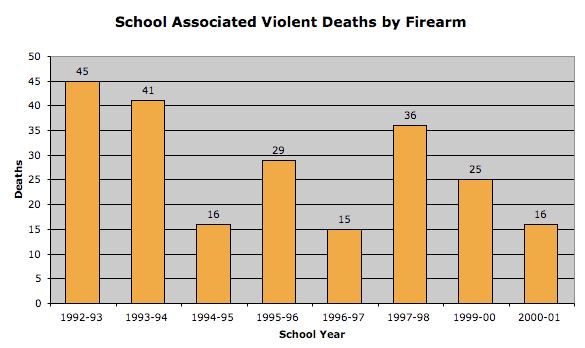Putting School Violence Into Perspective
by Sugi Sorensen
26-Mar-2001
The recent publicity given to school shootings at Granite Hills and Santana High Schools near San Diego has led to the perception that there is a widespread problem of violence in American schools. Heated rhetoric from the usual sources in the national press and from politicians in Washington set off my hyperbole detector.
Discarding the dominant media and politicians, I sought solace in the refuge of learned friends. I asked a friend finishing up his Ph.D. at a local university how many school kids he thought were killed by violence each year in the United States. He replied, "I don't know...definitely hundreds. Maybe thousands."
In truth, according to the National School Safety Center exactly six students have been murdered, committed suicide, or suffered weapons-related violent death in the United States in the 2000-2001 school year so far. This includes the much-publicized incident at Santana High School where Charles Andrew (Andy) Williams went on a shooting spree.
I wondered if six deaths was unusual. Was this number low or high in an average year? Had it been increasing or decreasing in the past few years? A quick search turned up the following data, which I've plotted:

The raw numbers can be found on the NSSC's website in a report entitled "School Associated Violent Deaths." Contrary to the myth of an increasing trend of school violence portrayed in the media, school-associated violent death has been in rapid decline since 1992. In fact, deaths had decreased 70.4% from the 1992-1993 school year to the last full school year measured (1999-2000.) Once again, truth demolishes perception.
A look inside the numbers reveals that the situation is even better than the raw numbers indicate. 16.4% of the deaths since 1992 (up to and including the Santee High School incident) were suicide-related. In all of these incidents, students (and some non-students) killed themselves on school property. Another 12.2% were gang-related, where the victims were typically targeted by rival gang members. While suicides and gang-related homicides are still problematic, in general they do not pose a risk to the average child attending school in the United States.
So why had my learned friend thought thousands of kids were being killed each year on America's school grounds? Among logical fallacies, this is known as a hasty generalization -- people are drawing conclusions about our population based on a sample that is too small. Humans are easy prey to anecdotal evidence. Our brains are hard-wired to find patterns in everything we sense. The perception, or more correctly misperception, of rampant school violence in American schools is fueled by media outlets that instinctively are drawn to extremes. As destructive as the consequences may be of a myopic press that feeds on sensational news, in the end it is the consumers of news who are ultimately to blame for their own misperceptions. We should expect newpapers to report murders and ignore benign events. We need to be more discriminating as consumers of news.
There is a more insidious force at work in the perception problem, though. These people intentionally misrepresent the facts to further their political agenda. They range from activist citizens, to news editors, to politicians. As Thomas Sowell expertly points out in his book The Vision of the Anointed, members of the anointed follow a pattern of declaring a crisis that can be solved only by coercive government solutions, which more often than not only exacerbate the stated problem or create new ones.
In the case of school violence, the pattern elucidated by Sowell is plainly clear. We now have a crisis in our schools, that can only be solved by more spending on government schools, increasingly Draconian school behavior policies, and concomitant liberty-limiting restraints such as stricter gun control laws. The law of unintended consequence invariably rears its ugly head. Children are suspended for drawing a picture of a gun, kids are arrested and imprisoned for writing up lists of students they dislike. Parents and adult citizens who have proven their utility in stopping shooting sprees are suddenly disarmed. Gun-free school zones necessarily exacerbate the level of mayhem that can be wrought by the occasional lunatic when they do strike.
We are asked to give up a little more liberty, or in the case of school violence, a little more of our children's liberty, in the name of promised security. Often the cure is worse than the disease. In the case of school violence, it's not even a disease. Our children stand much greater risk of death from accidents or disease than they do by the gun of a classmate.
Rather than panic, we need to abandon flight and stand fast. It is in moments of hysteria that humans act most irrationally. And much as a spooked herd often provides easy prey to skilled predators, irrational parents are hypnotized by the promises of political predators and stumble into surrendering more liberty. Instead we must be vigilant. We must resist the temptation to make hasty generalizations. Before we agree to any proposed solution, we must ask ourselves how bad the supposed problem really is. We should do our own research -- try to provide context to the numbers that are hurled at us from the press and from political predators. In the case of school violence, compare the risks of violent death to your child to other risks. For example, six times as many kids died playing high school football as were murdered in high school in the year 2000.
As tragic as the loss of life is in school, we need to keep problems in context. If the solutions we implement make our schools less safe, as gun-free zones do, or if they severely diminish the freedom of our kids, as zero-tolerance policies do, or if they wrongly institutionalize our children in increasing numbers, as new hate-crime or anti-bully laws tend to do, then we are making the problem worse.